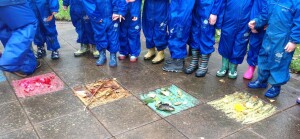As featured in – Grow Wild
How Carryduff Playgroup in Northern Ireland used wildflowers to develop a holistic, nature-focused foundation for their children’s learning
We’re celebrating the work of some of the amazing people and organisations across the Grow Wild community and the ways they’ve adapted to pandemic life. It has been a challenging time in many ways, for many people, but since they were able to reopen, Carryduff playgroup in Northern Ireland has used the opportunity of needing to spend more time outside as a learning tool and a way to familiarise children with the great outdoors. Deborah explains what they’ve been up to.

“We were trying to develop innovative ways for the children at our playgroup to make the most and learn from being more in contact with nature. It started off as a remote project during lockdown – sending parents that were still at home information about how they could engage the children with nature. We wanted to make it really accessible, so we started with activities that made use of things that were readily available in people’s gardens.
We sent out regular digital communications to the parents, to help encourage them and their families to engage with the activities, which were all based around nature and using natural materials as much as possible. We also encouraged them to recycle materials, for example, we showed them how to use old containers to make bird feeders.
In terms of what we did to prepare for the children’s return to playgroup, we wanted to make sure that the outdoor education could continue. We made plans to revive a forgotten-about little corner of our playground, which was very muddy and overgrown. That’s where Grow Wild came in! We cleared it to make what we now call our ‘wildlife wilderness’. We filled pallets with soil, and one with wood chip, and then when the children came back, they sowed the Grow Wild wildflower seeds, which was really educational for them. Some lovely flowers came up, and we’ve been able to use the space much more as a result.

First of all, we taught them all about watering every day. Then, as we were watching the flowers grow, we also measured them against our bodies to see how tall they grew. We then went online to learn all about wildflowers – so we expanded the learning opportunity from Grow Wild’s seeds into a holistic programme. We had great feedback from the parents, and the children were really engaged!
Since sowing the Grow Wild seeds, the area has become a nice place for the children to go on insect hunts, and nature trails, which has in turn developed our learning plans. Once the children came back for the start of the new term, we decided to widen our curriculum to have a much broader focus on outdoor and wildlife education. We wanted to embed all of our learning in nature as much as possible. We started to make nature crowns and nature bracelets, going for walks to gather twigs and leaves, and little petals. We made clay pendants, and placed terracotta pots for animals to live in. We’ve transformed the space from a playground into a living, learning resource in and of itself.
“We’ve transformed the space from a playground into a living, learning resource”
It’s given the children an awareness of what can be done outside, and that it’s not just about running around in the playground, there are so many other learning opportunities out there as well.
Inside, we’ve also transformed the space. We now use as many natural materials as we possibly can in our playroom. Instead of brightly coloured plastic toys, we have natural resources instead: baskets filled with selections of shells, pebbles, pinecones, teasels and more. We also created a “tree for all seasons” – this is a branch that we found outside, which we decorate according to the changing seasons. We’ve hung painted leaves on the tree to show that it’s autumn.
The biggest change that the parents have reported is that they appreciate their child spending more time outside and observing the outdoor areas, rather than being inside with the usual plastic fire engines and things. A plastic fire engine can only ever be a fire engine. But natural materials can be so much more! These kind of items really spark the children’s creativity in a way that other ways of learning can’t really do in the same way.”
